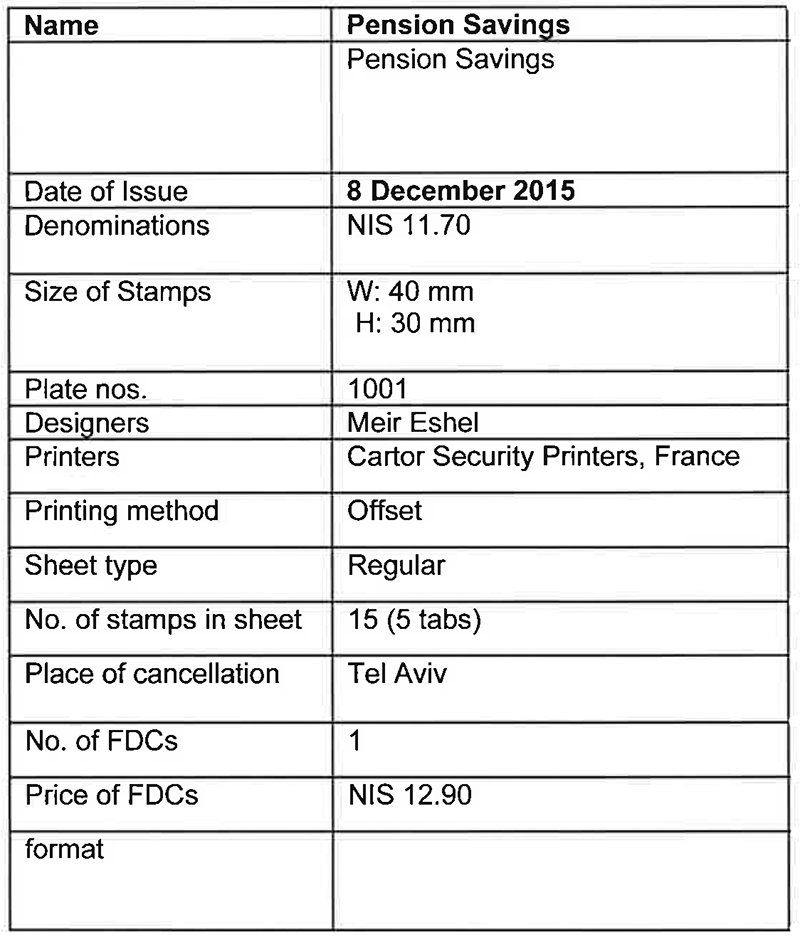“The last but not least in our Partridges and Allies ATM series is the cute Quail, the smallest of this species,” says Israel Post. This label is being issued in December. 
Category Archives: Israel 2015
Season’s Greetings (Israel 2015)
Theater and Entertainment Personalities (Israel 2015)
Theater and Entertainment Personalities – Channa Marron, Sefi Rivlin
December 2015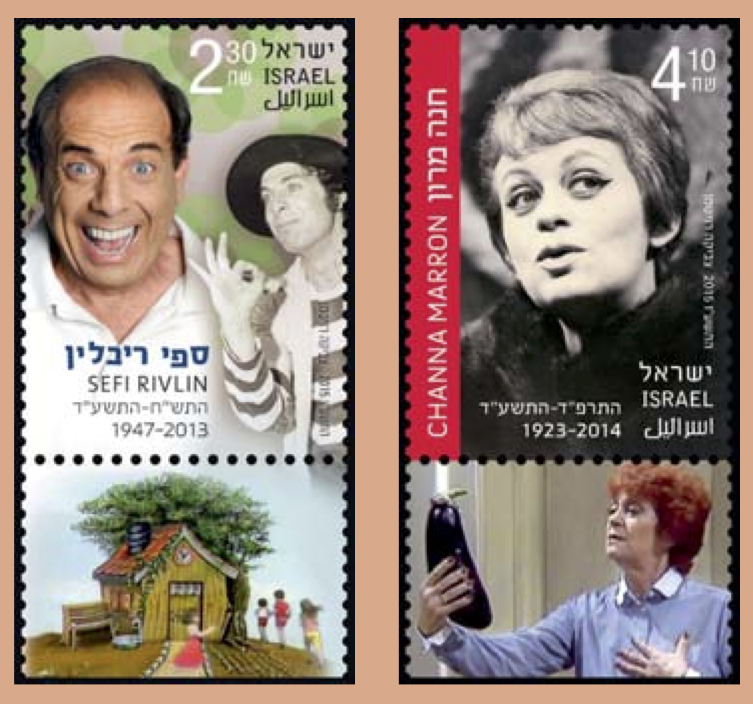
Channa Marron and Sefi Rivlin were two of the most prominent and iconic artists of the Israeli stage. Channa Marron, who was born in Berlin, was known mainly for classic theater while Sefi Rivlin, a native-born Israeli, was renowned for his comedic abilities. Each of these artists earned a place in the pantheon of Israeli culture.
Channa Marron 1923 – 2014
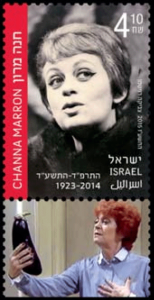 Channa Marron, née Mayerzak, known as the first lady of Israeli theater, began her acting career at the age of four in her native Berlin. Hanne’le Mayerzak starred in over twenty plays (including the first theater production of Pünktchen und Anton by Erich Kästner), seven films (including M – the first sound film by Fritz Lang) and numerous radio plays. In 1933 she had to leave Germany. After two years in Paris, where she portrayed leading roles in a number of plays, Mayerzak-Marron finally settled in Tel-Aviv and was soon integrated into the local Hebrew-speaking theater.
Channa Marron, née Mayerzak, known as the first lady of Israeli theater, began her acting career at the age of four in her native Berlin. Hanne’le Mayerzak starred in over twenty plays (including the first theater production of Pünktchen und Anton by Erich Kästner), seven films (including M – the first sound film by Fritz Lang) and numerous radio plays. In 1933 she had to leave Germany. After two years in Paris, where she portrayed leading roles in a number of plays, Mayerzak-Marron finally settled in Tel-Aviv and was soon integrated into the local Hebrew-speaking theater.
Channa Marron studied at Habima acting studio until, in 1941, she left to join the British Army. Following two years of service in Cairo, she was recruited by ENSA into the Jewish Brigade’s entertainment troupe, in which she played a key and memorable role.
After WWII Ms. Marron joined the founders of the Cameri Theater and took part in the formation of the theater’s distinctive character. Marron performed in dozens of Cameri productions, and is especially remembered for her portrayal of key roles in classic dramatic plays first translated or performed in Hebrew (including major works by Shakespeare, Schiller, Ibsen, Chekhov, Seneca, Wilde, Bernard Shaw, Eugene O’Neill, Tennessee Williams, Arthur Miller, Jean Anouilh, Beckett and Pinter) as well as classic plays by Israeli playwrights from Shamir, Alterman and Goldberg to Shulamit Lapid and finally Hanoch Levin.
In February 1970, while starring in a musical stage production of Hello Dolly, Marron was severely injured in a terrorist attack at Munich Airport. Her left leg was amputated in order to save her life. A mere one year later, Marron was back on the Cameri Theater stage as Medea in the play by Seneca. From the early 1980’s she began performing in other theaters, including Habima and Beer Sheva and also starred in the well known television series Krovim Krovim (Close Relatives). In addition to the many theater productions in which she took part, Marron also participated in seven Israeli films (directed by Avraham Hefner, Amos Gitai, Moshe Mizrahi), she was versed and involved in Hebrew poetry and devoted to its reading, and taught and directed at Beit Zvi School of Performing Arts and at Tel Aviv University. In 2000, Channa Marron was among the founders of the Herzliya Ensemble theater company, where she performed and also directed. Marron was active in political and civil organizations and initiatives promoting peace and coexistence in the region.
Channa Marron received many awards for her work in the theater and cinema, as well as her artistic endeavors, including the Israel Prize in 1973.
Thanks to Dr. Ofra Rechter, daughter of Channa Marron and Dor Wertheimer, Channa Marron Archive.
Sefi Rivlin 1947 – 2013
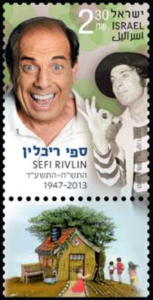 Yosef (Sefi) Rivlin was a versatile, respected and beloved actor and comedian, a virtuoso and one of Israel’s premier artists.
Yosef (Sefi) Rivlin was a versatile, respected and beloved actor and comedian, a virtuoso and one of Israel’s premier artists.
His diverse career spanned a wide range of roles in the theater, film, festivals, musicals, one-man shows, television series and more.
He was awarded the Israeli Television Academy Award and a Golden Mask Prize for lifetime achievement.
Sefi Rivlin studied acting at the Beit Zvi School for Performing Arts and belonged to the original Khan Theater troupe when it was founded in 1973. His first starring role was in Servant of Two Masters, for which he was nominated for a Kinor David Award.
He participated in many televisions series, first as a cast member on the satirical show Nikui Rosh and later Rega im Dodley, BaBayit shel Fistuk, HaTizmoret, Itche and more. Rivlin portrayed numerous film roles, including the leading role in HaShiga’on HaGadol.
Alongside his artistic success, Sefi volunteered for many years in his city of Rishon LeZion and was recognized by the city as an honored citizen. A social activist, he served on the city council and as a cultural advisor to the mayor. He worked to encourage reading, founded a club that conducted classes for adults and youths, volunteered with medical organizations and promoted the establishment of centers for art and the Hebrew language.
Sefi Rivlin was a bold comedic actor, exuding a charming and captivating kind of madness.
Gidi Marinsky, Israel Philatelic Service
Description of the Stamps and the First Day Covers:
Channa Marron
The stamp features a photographed portrait by Israel Haramaty and a photograph from the television series Krovim Krovim, courtesy of Israel Educational Television. The First Day Cover features a caricature by Zeev (Yaakov Farkash) from the Zeev Collection, the Israeli Cartoon Museum, Holon courtesy of his daughters Naomi Farkash- Fink and Dorit Farkash-Shuki.
Sefi Rivlin
The stamp features a photographed portrait by Raphael Ben Dor.
The stamp and tab feature photographs from the television series BaBayit shel Fistuk. The FDC bears an illustration by Zina Roitman of Sefi Rivlin based on a photograph of a scene from BaBayit shel Fistuk.
Pension Savings (Israel 2015)
December 2015
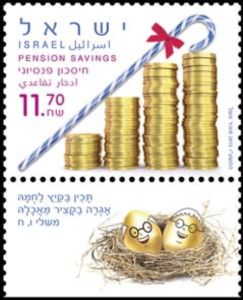 Pension Savings is a comprehensive term for the provident and pension funds that ensure sufficient income after retirement. Most pension funds include a savings component and an insurance component that protects the client and his family in case of death or injury. The State of Israel decided to encourage pension savings by offering a significant tax benefit to employees.
Pension Savings is a comprehensive term for the provident and pension funds that ensure sufficient income after retirement. Most pension funds include a savings component and an insurance component that protects the client and his family in case of death or injury. The State of Israel decided to encourage pension savings by offering a significant tax benefit to employees.
Overall pension savings have increased from NIS 180 billion in 2001 to some NIS 600 billion in 2014. Thirty percent of pension savings are invested in designated government bonds, linked to CPI plus 4.8% interest. This growth significantly increased the inflow of funds to the Israeli stock market and has turned pension savings into a significant player in the Israeli capital market.
In 2003, the retirement age was raised in order to decrease government expenses and increase future pension payments. Today, pension fund clients are able to move their pension savings from one fund to another with no limitations.
Pension contributions have been mandatory for all employers and employees since 2008 – a step that added 1 million employees to the population of savers. Mandatory pension applies to all employees from age 21 for men and age 20 for women to retirement age.
In 2015, The Department of Capital Market, Insurance and Savings at the Ministry of Finance announced a planned reform in the pension savings market, which will include steps to reduce centralization and to increase competition, in view of the fact that the pension sector is the fastest growing sector in Israel’s financial market.
Israeli Nostalgia (Israel 2015)
December 2015 During the past decade, a wave of nostalgia has swept through Israel and the world. This nostalgia stems from a sense that the progressive world in which we live, with its rapid technological advances and terms such as “global village” and “virtual world” creates feelings of alienation, as opposed to the intimacy remembered from earlier times.
During the past decade, a wave of nostalgia has swept through Israel and the world. This nostalgia stems from a sense that the progressive world in which we live, with its rapid technological advances and terms such as “global village” and “virtual world” creates feelings of alienation, as opposed to the intimacy remembered from earlier times.
Thus, we look back to a place where we felt content, comfortable and safe – to childhood, to the past, to the pleasant realm of nostalgia. The Tembel Hat, Soda Siphon and Sussita car featured in this stamp series are examples of things that remind us of days gone by and fill us with pleasant memories of the past.
Tembel Hat
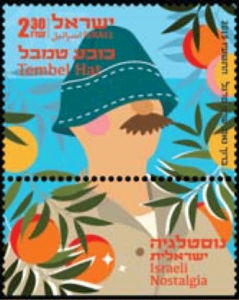 In the early days of the State of Israel nearly everyone wore Tembel hats, making it a common symbol of “the Israeli”. This is how renowned caricaturist Dush represented the mythological Sabra Srulik, along with his short khaki pants, open collared shirt and sandals. The Tembel hat was popular because it was inexpensive (it was produced from scraps of textile fabrics), it could be used to wipe sweat from the wearer’s face, folded into a triangle that fit comfortably into a pant pocket, and was easy to wash.
In the early days of the State of Israel nearly everyone wore Tembel hats, making it a common symbol of “the Israeli”. This is how renowned caricaturist Dush represented the mythological Sabra Srulik, along with his short khaki pants, open collared shirt and sandals. The Tembel hat was popular because it was inexpensive (it was produced from scraps of textile fabrics), it could be used to wipe sweat from the wearer’s face, folded into a triangle that fit comfortably into a pant pocket, and was easy to wash.
Soda Siphon
 The Soda Siphon was a metal container used to produce “homemade” soda. Water was turned into soda when gas from a small container attached to the siphon released bubbles into the device.
The Soda Siphon was a metal container used to produce “homemade” soda. Water was turned into soda when gas from a small container attached to the siphon released bubbles into the device.
The Soda Siphon was so popular in its day that it became a common wedding gift. In a wellknown skit called “Wedding Photographer”, Israeli comedian Gadi Yagil said, “… do you know that you got 100 Soda Siphons? What do you do in your spare time? Make soda?…”.
Sussita
 The Sussita car was assembled in Israel from 1960 to 1975 at the Autocars factory in Tirat Hacarmel. The body was made of fiberglass. According to a common tale, the Sussita was favored by camels in Southern Israel, because they could bite off chunks and gleefully eat them. A number of Sussita models were manufactured: a 2-door model that looked like a box and was nicknamed accordingly; a station wagon; and a Sussita pick-up truck that had a passenger-cab in the front and a load cab in the back.
The Sussita car was assembled in Israel from 1960 to 1975 at the Autocars factory in Tirat Hacarmel. The body was made of fiberglass. According to a common tale, the Sussita was favored by camels in Southern Israel, because they could bite off chunks and gleefully eat them. A number of Sussita models were manufactured: a 2-door model that looked like a box and was nicknamed accordingly; a station wagon; and a Sussita pick-up truck that had a passenger-cab in the front and a load cab in the back.
—David Sela
Chairman, Council for Promoting Israeli Heritage
Editor of the Israeli Online Nostalgia website
The themes for the stamp series were selected based on a survey of the 202,281 members of the Online Nostalgia website. Of those surveyed, 13,103 gave the most votes to the selected items. Our thanks to David Sela and the Online Nostalgia website for their assistance. 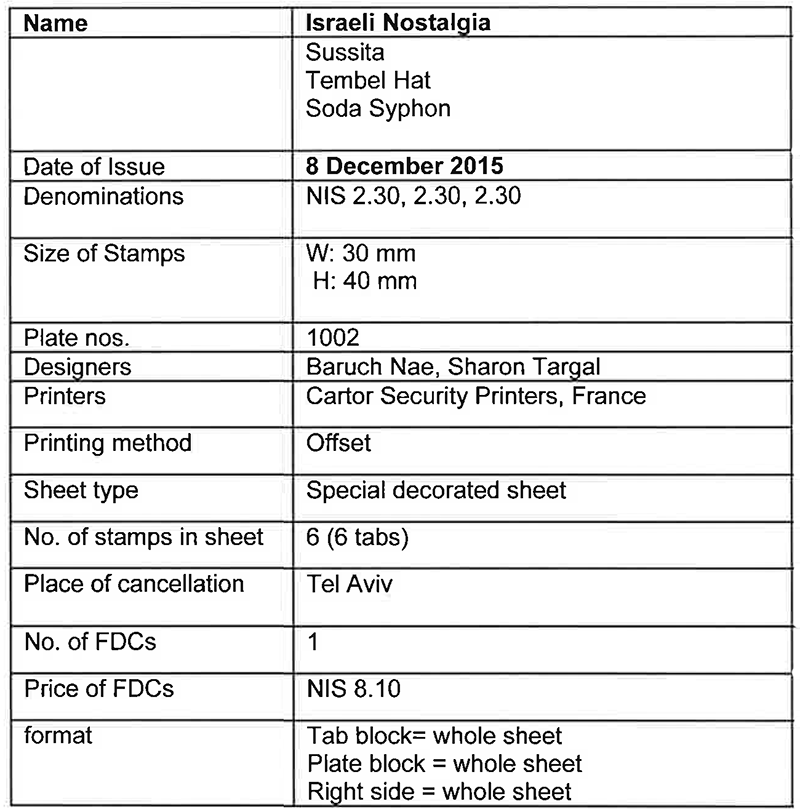
Nili Centenary (Israel 2015)
December 2015
Nili: acronym for “Netzach Israel Lo Yishaker” The Eternity of Israel will not deceive (Samuel I, 15:29)
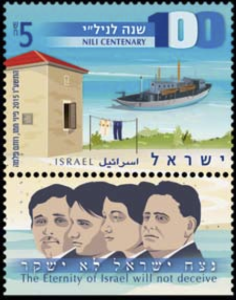 Dreamers and warriors, bearers of the rebellion against the Ottoman Empire.
Dreamers and warriors, bearers of the rebellion against the Ottoman Empire.
The underground Nili network was established in 1915 and operated in Eretz Israel during WWI. Its objectives were:
- To assist the British effort to conquer Eretz Israel by gathering information.
- To support the Jewish Yishuv in Eretz Israel in a time of famine and disease.
- To draw world attention to what was happening in Eretz Israel.
- To fulfill the dream of establishing a Jewish State in Eretz Israel.
Nili was founded and led by agronomist Aaron Aaronsohn from Zikhron Ya’akov, joined by his sister Sarah and brother Alexander, as well as Avshalom Feinberg from Hadera, brothers Na’aman and Eitan Belkind from Rishon LeZion, Yosef Lishansky from Metula and dozens of others.
The organization operated from Atlit where Aaron’s Agricultural Experiment Station was located. British forces sailed regularly between Egypt and Atlit – the British warship Managam frequently came ashore at Atlit to collect the information gathered by Nili members. Information was also passed on via homing pigeon.
In the spring of 1917 rumors about the espionage organization circulated around the Yishuv. A number of events led to the exposure of the organization in September 1917: a British coin was found in the market in Ramleh, a homing pigeon failed to complete its mission and landed in the governor’s yard in Caesarea and Na’aman Belkind was arrested by Turkish authorities.
Following these events, the Turks began a campaign of threats and terror against the Jewish Yishuv in order to apprehend Nili members. Many were in fact caught and tortured. Sarah Aaronsohn committed suicide after undergoing severe torture. Na’aman Belkind and Yosef Lishansky were executed in Damascus.
The bravery and heroism of the men and women of Nili helped the British enter Eretz Israel and end the Ottoman rule.
—Beit Aaronsohn Nili Museum
Description of the Stamp, the First Day Cover and the Cancellation
The stamp features the British warship Managam across from the Atlit shore and the house in the vineyard in Zikhron Ya’akov from which they signaled the Managam.
The stamp tab features portraits of Aaron Aaronsohn, Sarah Aaronsohn, Avshalom Feinberg and Yosef Lishansky.
The First Day Cover bears a picture of the house in the Agricultural Experiment Station from which the Managam was signaled. The signals were made by opening and closing the shutters or hanging dark or white laundry.
The cancellation features Aaron Aaronsohn’s home on Ha’Meysadim (founders) St. in Zikhron Ya’akov.
The Mamluk Postal Road – Philately Day (Israel 2015)
December 2015
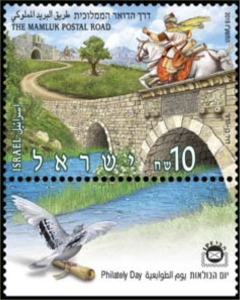 The Postal Road established by the Mamluk Empire in Eretz Israel (1260-1516) ran from the capital in Cairo to the capital of the north – Damascus and other important centers. This main route and its branches served as a means of passing news between the outlying areas of the Empire and the capital.
The Postal Road established by the Mamluk Empire in Eretz Israel (1260-1516) ran from the capital in Cairo to the capital of the north – Damascus and other important centers. This main route and its branches served as a means of passing news between the outlying areas of the Empire and the capital.
The road from Egypt, which passed through the northern Sinai Desert, forked into two branches in Gaza – one toward Karak in Jordan via Beit Guvrin and Hebron and the other toward Damascus via Jitin (Ge’a), Qatra (Gedera), Ludd, Jinin, Baysan (Beit She’an), etc.
The Mamluk postal network was based on three components: equestrian post, homing pigeons and fire/smoke signals. This system was called Barid. The land Barid utilized fast horses whose sole purpose was to transport messages from the Sultan in Cairo. The messengers who rode these horses were selected from among those closest to the ruler.
The fourth Mamluk Sultan, al-Zahir Baybars al- Bunduqdari (1260-1277), who established the Mamluk Empire, reintroduced the Barid and incorporated it into his military structure. The peak of the Barid was during the third reign of al-Nasir Muhammad ibn Qalawun (1310-1341).
This postal system was based on stations positioned at regular intervals along the route where messengers were able to obtain fresh horses. Approaching messengers were recognized by station personnel based on identifying marks such as a yellow silk scarf tied to the messenger’s neck, a large silver medallion hanging from the messenger’s neck or a horse with a tied tail – and were met with a fresh horse so they could continue immediately on their journey.
It took no more than four days for the post to reach Damascus from Cairo.
In order to minimize the obstacles en route, Baybars built and repaired bridges. This Sultan’s hallmark – the lion/cheetah – appears on many of his buildings (and also on the stamp) and it decorated at least two of the bridges that he built: one near Cario and the other the Gandas Bridge near Lod which was one of the main stations along the Barid.
The Mamluk Postal Road left its impression on Eretz Israel and a number of impressive ruins from that network attest to its importance as a key land bridge among various countries.
—Dr. Katia Cytryn-Silverman
Lecturer at the Institute of Archaeology and the Department of Islamic and Middle Eastern Studies, The Hebrew University of Jerusalem
World War I Mule Corps (Israel 2015)
[press release]
The Founding of the Mule Corps
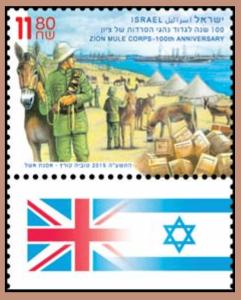 At the onset of WWI, the Turks who ruled Eretz Israel expelled all citizens of enemy countries who refused to become Ottoman subjects. Many of those expelled were Jews who had come from Russia before the war and nearly 11,000 of them made their way to the Egyptian city of Alexandria, which was under British rule.
At the onset of WWI, the Turks who ruled Eretz Israel expelled all citizens of enemy countries who refused to become Ottoman subjects. Many of those expelled were Jews who had come from Russia before the war and nearly 11,000 of them made their way to the Egyptian city of Alexandria, which was under British rule.
Ze’ev Jabotinsky, who came to Alexandria from Russia as a military correspondent in early December 1914, proposed founding a volunteer Jewish combat battalion that would participate in the efforts to conquer Eretz Israel from the Turks. Aided by Joseph Trumpeldor, who had come to Alexandria after being expelled from Eretz Israel, he recruited some 200 young Jews from among the expelled as well as the local Egyptian Jewish community. Participants in a meeting held on March 5, 1915 signed a binding agreement to serve in the battalion.
Although the British refused to establish a Jewish combat unit, they did agree to form a transport corps of Jewish mule drivers. Disappointed, Jabotinsky left Egypt and travelled to London to continue to promote the idea of a Jewish combat battalion. Trumpeldor, on the other hand, accepted the British proposition and volunteered to help establish the corps.
On April 1, 1915 the members of the Zion Mule Corps, or as they were known “The Mule Corps”, were sworn in. Anglo-Irish Lt. Colonel John Henry Patterson was appointed to command the corps and Joseph Trumpeldor became his second-incommand.
The Corps on the Gallipoli Front
In April 1915, a large British military force landed on the shores of the Gallipoli peninsula, not far from the city of Istanbul, the capital of the Ottoman Empire. On April 16, 1915, after only a brief twoweek training period, the Mule Corps joined the main force which had landed on the southern shore of Gallipoli. The stamp is adapted from a photo of the Mule Corps soldiers as they came ashore in Gallipoli.
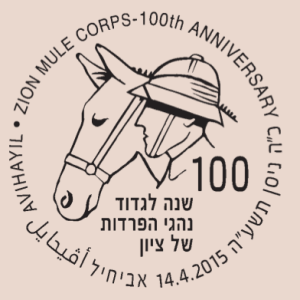 It quickly became apparent that the British action on the Gallipoli peninsula was a failure. The Turks fought fearlessly and the invading forces suffered heavy casualties. The Mule Corps soldiers, who transported ammunition and supplies to the troops on the front line, executed their difficult and wearing job very well. Despite the danger and the terrible conditions, the Jewish volunteers persevered under fire, in the mountainous terrain of the peninsula, until the British withdrawal and departure from Gallipoli on the night of January 1, 1916. During this period the Corps suffered nine casualties and approximately 50 of its men were wounded. Ninety men were present at the final parade before the British departure, approximately 25% of the original force, and only 11 of them were among the volunteers who had come ashore on April 27, 1915.
It quickly became apparent that the British action on the Gallipoli peninsula was a failure. The Turks fought fearlessly and the invading forces suffered heavy casualties. The Mule Corps soldiers, who transported ammunition and supplies to the troops on the front line, executed their difficult and wearing job very well. Despite the danger and the terrible conditions, the Jewish volunteers persevered under fire, in the mountainous terrain of the peninsula, until the British withdrawal and departure from Gallipoli on the night of January 1, 1916. During this period the Corps suffered nine casualties and approximately 50 of its men were wounded. Ninety men were present at the final parade before the British departure, approximately 25% of the original force, and only 11 of them were among the volunteers who had come ashore on April 27, 1915.
The End of the Mule Corps
A few months after returning to Egypt, the Mule Corps was disbanded on May 26, 1916. At Trumpeldor’s initiative, some 120 members of the corps reenlisted. They were sent to Britain, where they served as the core of the newly formed 38th Battalion of the Royal Fusiliers, the first Jewish combat unit within the framework of the British military.
Description of the First Day Cover
The First Day Cover incorporates the façade of the Beit Hagdudim (Jewish Legions) Museum – Avichail, which commemorates the memory and heroism of the members of the Jewish battalions of WWI. The quote taken from the founding declaration of the Mule Corps: “A corps of Jewish volunteers that shall make itself available to the government of England in order to participate in the liberation of Eretz Israel… every volunteer shall swear to sacrifice his strength and his life” symbolizes the courage and sacrifice of the pioneers of the first Jewish military force of the modern era.
Issue: April 2015
Stamp Size (mm): H30/W40
Plate: 979
Stamps per Sheet: 15
Tabs per Sheet: 5
Method of printing: Offset
Security mark: Microtext
Printer: Cartor Security Printing, France
Stamp & Cancellation Design: Osnat Eshel, Tuvia Kurtz
FDC design: Osnat Eshel
Chess (Israel, 2015)
This stamp will be issued February 10th.
[from Israel Post
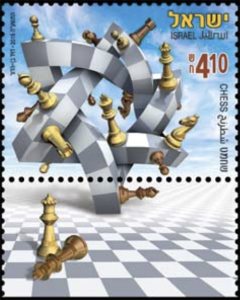 Chess is one of the most prevalent games in the world. It is thought to have been invented in India in the 6th century CE and was popular among the Arab nations and in Persia. The game reached Europe around the 10th century, and the modern rules of the game were established there in the 15th century. Since then, this version of the game has spread throughout the world.
Chess is one of the most prevalent games in the world. It is thought to have been invented in India in the 6th century CE and was popular among the Arab nations and in Persia. The game reached Europe around the 10th century, and the modern rules of the game were established there in the 15th century. Since then, this version of the game has spread throughout the world.
Chess is mentioned in the Kuzari, written by medieval Spanish philosopher and poet Rabbi Yehuda Halevi, as well as in writings by Rashi and Maimonides, and Abraham ibn Ezra even dedicated one of his poems to the game. Chess was mentioned many times in our literary sources for a good reason: this game has been extremely popular among Jews, who have also had significant achievements in this field. Four of the 16 World Champions were Jewish and three others were half-Jewish. Many other Jewish players were (and still are) at the international pinnacle of the game. Jewish excellence in chess is so prominent that the game has been called “the national Jewish game”.
This tradition has continued in Israel, and Israeli chess masters have achieved more than sportsmen in any other field: the Israeli national team is among the top-ranked in the world, with its highest achievements being second place at the Chess Olympic Games in Dresden in 2008 and third place at the Khanty-Mansiysk Games in Russia in 2010. The national team won second place at the European Championships in 2003 and 2005.
Israeli chess Grandmaster Boris Gelfand challenged then World Champion Viswanathan Anand for the World Chess Championship in 2012. Although the match ended in a draw, Gelfand lost by a minimal margin in the rapid tiebreaker games and had to settle for the title of World Championship runner-up.
Israeli women have also recorded a number of substantial achievements, among them winning the Women’s Chess Olympic Games in Haifa 1976 (which was boycotted by the strong Eastern- European countries). In 1978, Grandmaster Alla Kushnir-Stein fell just short of competing for the world title when she was beaten in the final round of the contenders’ competition by Maia Chiburdanidze of the USSR.
Thanks to these achievements and many more, Israel was granted the opportunity to host a number of important events: the Chess Olympic Games in 1964 (Tel-Aviv) and 1976 (Haifa), the European National Championship (Haifa, 1989), the World Youth Chess Championship (Jerusalem, 1967), the Team World Cup (Beer Sheva, 2005) and more.
Israel’s integration into the international chess arena began even before the establishment of the State. In fact, the first sports delegation to participate in an international competition under the flag of Eretz Israel was the delegation to the Warsaw Chess Olympic Games in 1935, which was comprised solely of members of the Jewish Yishuv. The first official sports meeting between Israel and any of the Arab countries took place at the Chess Olympic Games in Varna (1962), when Israel’s national chess team beat the Tunisian team with the score of 3:1.
This stamp is being issued to mark the European Individual Chess Championship 2015 which will be held in Jerusalem. The design reflects the connection between chess and Judaism and Israel, as well as chess’ status as Israel’s national sport and its number one representative sport.
Winter Flowers (Israel, 2015)
These stamps will be issued February 10th.
[from Israel Post]
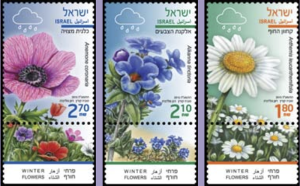 Most of Israel’s wild flowers bloom in spring, the soil is moist from the winter rains and temperatures are warm.
Most of Israel’s wild flowers bloom in spring, the soil is moist from the winter rains and temperatures are warm.
However, some of Israel’s wild flowers bloom much earlier during the growth season. Such are the well known Sternbergia and Autumn Crocus (Colchicum) which bloom in fall; and quite a number of flowers bloom at the height of winter, when the weather is cold and rainy. Most autumn flowers are sparse or bloom in small patches, while the early winter flowers normally form spectacular blooming carpets. Their short growth season enables them to bloom several weeks after the first rains of the season in mid-winter. The early blooming helps these flowers avoid competition for resources – water and soil nutrients, light, and especially pollination services (mostly by insects such as bees and beetles), as opposed to spring blooming flowers.
Early blooming is typical to relatively arid areas such as sandy areas of the Coastal Plain, and the Northern Negev, where the soil dries early, so early blooming is an advantage.
Coast False-Chamomile (Anthemis leucanthemifolia)
This semi-recumbent annual plant forms spectacular blooming carpets on the coastal sand fields as early as January. Unlike other species of False-Chamomile of Israel, it has succulent leaves which are wedge-shaped, and not pinnate; and the inflorescences are relatively large and dense.
The False-Chamomile species belong to the Daisy family, which is characterized by its flower-like inflorescences. It has many white flowers which look like petals, arranged in the outer circle of the inflorescence and numerous yellow flowers in the center which resemble stamens. The inflorescence appears to pollinating insects to be a flower (as it does to humans).
The Coast False-Chamomile is endemic to the coastal plains of Israel and Southern Lebanon, and grows nowhere else in the world.
Dyer’s Alkanet (Alkanna tinctoria)
This recumbent perennial plant is covered with rough bristles, as are many other plants belonging to the Borage family. During much of the year the Alkanet is a dull looking plant, but in winter and early spring it displays a profusion of bright blue flowers.
The root coat of Dyer’s Alkanet is red and was used in the past to produce a red dye. When rubbed on paper, it dyes the paper bright red. The plant’s scientific name stems from this: Alkanna is the Latin form of the Arabic word “Al- Hinna” – the general term for yellow-red dyes produced from plants. The word tinctoria means “of the dyers”.
Crown Anemone (Anemone coronaria)
Everyone in Israel knows the Crown Anemone, one of Israel’s most beautiful wild flowers. The Hebrew name “Kalanit” is derived from the same source as the word for bride – “Kala”. Crown Anemones bloom from early winter through the end of spring, forming magnificent flowering carpets.
The red variety of the Crown Anemone grows through much of the country, while the multicolored variety, in colors ranging from white to deep purple through all shades of pink and blue, grows mainly in the north. The multi-colored variety is sensitive to lime, and thus is rare in lime-rich soils. It is abundant mainly in the basaltic soils of the eastern Galilee and the Golan, and in the deep soils of the northern valleys. The red variety which grows through much of the country is drought-hardy and creates blazing flowering fields in the south.
—Hagar Leschner
Collection Manager of the National Herbarium, The Hebrew University of Jerusalem



